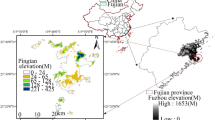Abstract
Urban expansion necessitates proper planning to avoid profound negative environmental and socioeconomic impacts. The main objective of the study was to analyze the spatiotemporal changes that occurred in Jigjiga town in the last three decades. To meet the intended objectives, geographic information system (GIS) and remote sensing technologies were employed. The results of the study disclosed that urban expansion of Jigjiga town was largely caused by the increasing built-up area from 4.2% in 1985, 5.2% in 2005 to 24% in 2015 out of Jigjiga’s township area of 7492 ha due mainly to natural increase of the population, urban ward migration, and most recently, a change in status of the town from zonal capital to regional capital. This uncontrolled expansion towards peri-urban neighborhoods has exerted pressure on cropland and vegetation. Cropland has declined from 3836.6 ha (51.6% of Jigjiga’s township area of 7492 ha) in 1985 to 2486.0 ha (33.2%) in 2015. Areas covered by forest increased by 84.8 ha in the first decade (1985–1995) and by 218 ha in the second decade (1995–2005), but towards the last decade (2005–2015), about 231 ha of forestland was converted to built-up area. The decline of grassland especially in the southern part of the town and its surrounding rural area was also very significant. In the last three decades, about 463 ha of grassland was converted largely to built-up areas. Therefore, controlling and monitoring of urban expansion using GIS and remote sensing technologies are vital solutions to protect peri-urban neighborhoods from adverse effects of urbanization.



Similar content being viewed by others
References
Allen J, Lu K (2003) Modeling and prediction of future urban growth in the Charleston region of South Carolina: a GIS-based integrated approach. Conserv Ecol 8(2):2 [online] http://www.consecol.org/vol8/iss2/art2/
Anderson JR, Hardy EE, Roach JT, Witmer RE et al (1976) A land use and land coverclassification system for use with remote sensor data (revised). U.S. Geological Survey 964, pp 28
Burrough A, McDonnell A (1998) Principles of geographical information systems. Oxford University Press, Oxford
Dewan AM, Yamaguchi Y (2008) Using remote sensing and GIS to detect and monitor land use and land cover change in Dhaka Metropolitan of Bangladesh during 1960–2005. Environ Monit Assess 150(1–4):237–249. https://doi.org/10.1007/s10661-008-0226-5
Drogue G, Pfister L, Leviandier T, Humbert J, Hoffmann L, el Idrissi A, Iffly JF (2002) Using 3D dynamic cartography and hydrological modelling for linear streamflow mapping. Comput Geosci 28(8):981–994
Gadal S (2009) Remote sensing monitoring of rural urbanization in Jaipur region. In: Proceedings of the 4th international conference Rural development 2009. The transitions towards sustainability. Kaunas, Lithuania, pp 15–17
Goetz A (2013) Suburban sprawl or urban centres: tensions and contradictions of smart growth approaches in Denver, Colorado. Urban Stud 50(11):2178–2195
Grimm NB, Grove JM, Pickett STA, Redman CL (2000) Integrated approaches tolong-term studies of urban ecological systems. BioScience 50:571–584
Herold M, Goldstein NC, Clarke KC (2003) The spatiotemporal form of urban growth: measurement, analysis and modeling. Remote Sens Environ 86:286–302
Kumar J, Garg K, Deepak K (2008) Monitoring and modelling of urban sprawl using remote sensing and GIS techniques. Int J Appl Earth Obs Geoinf 10(2008):26–43
Lillesand M, Ralph W (2000) Remote sensing and image interpretation. John Wiley & Sons, Hoboken
Liu X, Lathrop RG (2002) Urban change detection based on an artificial neural network. Int J Remote Sens 23(12)
Mesev V (ed) (2007) Integration of GIS and remote sensing. John Wiley & Sons, New York
Pilouk M, Abdul-Rahman A (eds) (2007) Spatial data modelling for 3D GIS. Springer Berlin Heidelberg, Berlin
Sudhira HS et al (2003) Urban growth analysis using spatial and temporal data. Journal of the Indian Society of Remote Sensing 31(4):299–311
Yuan F, Sawaya KE, Loeffelholz B, Bauer ME (2005) Land cover classification and change analysis of the Twin Cities (Minnesota) Metropolitan Area by multitemporal Landsat remote sensing. Rem Sen Envi 98:317–328
Author information
Authors and Affiliations
Corresponding author
Rights and permissions
About this article
Cite this article
Barow, I., Megenta, M. & Megento, T. Spatiotemporal analysis of urban expansion using GIS and remote sensing in Jigjiga town of Ethiopia. Appl Geomat 11, 121–127 (2019). https://doi.org/10.1007/s12518-018-0245-z
Received:
Accepted:
Published:
Issue Date:
DOI: https://doi.org/10.1007/s12518-018-0245-z




